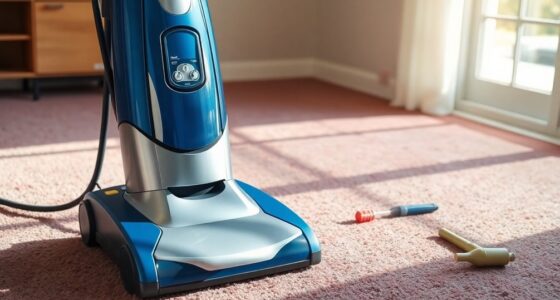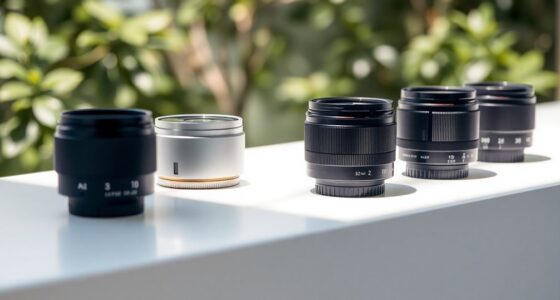To create a minimalist newsletter, focus on simplicity. Start by defining your core message and value proposition to engage your audience. Choose a clean layout with a cohesive color palette and sans-serif fonts for readability. Incorporate high-quality visuals and clear calls-to-action that stand out. Test your design across devices to guarantee compatibility. Finally, gather feedback to improve continuously. Stick around to discover more tips that'll elevate your newsletter design game!
Key Takeaways
- Start by defining your core message and value proposition to ensure content resonates with your audience.
- Choose a simple layout with a maximum width of 600 pixels for enhanced readability and visual hierarchy.
- Select a cohesive color palette using the 60-30-10 rule and opt for sans-serif fonts for better legibility.
- Incorporate high-quality visuals and clear calls-to-action that stand out while maintaining a balanced text-to-image ratio.
- Test your design across multiple devices and email clients for compatibility, ensuring links and images load correctly.
Understanding Minimalism in Newsletter Design
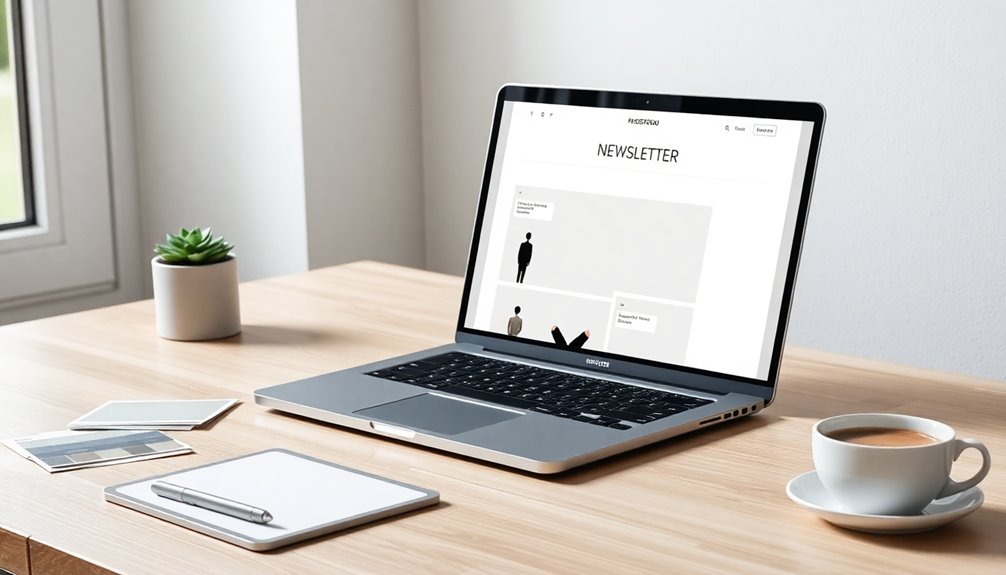
Minimalism in newsletter design prioritizes simplicity, creating a clearer and more engaging experience for readers. By adopting a minimalist approach, you can limit sections and links, focusing only on essential content that captivates your audience.
This design strategy emphasizes the use of ample white space, which contributes to a clean layout that's easy to scan and navigate.
Your typography choices play an essential role as well; opting for sans-serif fonts enhances legibility and keeps the design modern. A cohesive color palette further elevates the aesthetic appeal while maintaining focus on your core message.
Ultimately, minimalist newsletter design streamlines communication, ensuring your subscribers receive information without feeling overwhelmed by clutter or distractions. Incorporating budget planning techniques can also help in designing newsletters that are cost-effective and resource-efficient.
Defining Your Core Message and Value Proposition

To create a successful newsletter, you need to pinpoint your core message and clarify your value proposition.
Think about what unique insights or resources your audience craves and how you can meet those needs.
Engaging with your subscribers will help you refine these elements and keep their interest alive. Additionally, understanding user behavior patterns can greatly enhance how you tailor your content to resonate with your audience.
Core Message Identification
Identifying your core message is essential for creating a newsletter that truly resonates with your audience. Start by defining your primary value proposition—what makes your newsletter unique and beneficial to your target audience.
Conduct thorough audience research to uncover their needs, preferences, and pain points; this insight will help you refine your core message. Use concise language and strong keywords to communicate your value proposition effectively.
Don't forget to highlight the benefits of subscribing in your introduction and CTAs, making it clear how your content enhances the reader's experience. Regularly evaluate and iterate on your core message based on subscriber feedback and engagement metrics to keep it relevant and compelling. Additionally, incorporating topical authority into your content strategy can significantly enhance your newsletter's effectiveness and reach.
Value Proposition Clarity
Creating a clear value proposition is essential for your newsletter's success, as it defines what sets your content apart and why subscribers should choose you.
Here are three key elements to guarantee value proposition clarity:
- Be Concise: Limit your value proposition to one or two sentences that capture the main benefits of your newsletter content.
- Use Data: Incorporate specific metrics, like subscriber growth and engagement rates, to highlight your effectiveness as part of your email marketing strategy.
- Refine Regularly: Continuously revisit and adjust your value proposition based on subscriber feedback and performance metrics to align with their evolving needs. Additionally, understanding strong communication skills can enhance your ability to convey your value proposition effectively.
A well-designed newsletter with a strong value proposition enhances subscriber engagement, fostering loyalty and retention over time.
Audience Engagement Strategy
A clear value proposition sets the foundation for your audience engagement strategy, ensuring your newsletter resonates with your subscribers.
To define your core message, identify the unique benefits your audience gains from your content. Use consistent branding elements in your email design to foster familiarity and trust.
Tailor your newsletter for different audience segments based on interests or behaviors, delivering targeted content that speaks directly to their needs.
Regularly solicit feedback to refine your core message, keeping it relevant and aligned with subscriber preferences. This approach boosts engagement, enhances retention rates, and builds a loyal community around your newsletter, ultimately reflecting the importance of social connections in fostering a successful relationship with your audience.
Choosing the Right Layout and Color Palette

When you're choosing a layout for your minimalist newsletter, think about clarity and ease of navigation.
A well-structured design paired with a thoughtful color palette can greatly enhance your readers' experience.
Let's explore how layout principles, color theory, and visual hierarchy work together to create a cohesive and engaging newsletter. Additionally, incorporating content clusters can help organize information effectively, guiding readers through your newsletter with ease.
Layout Principles for Clarity
To achieve clarity in your newsletter design, selecting the right layout and color palette is essential.
Focus on these layout principles to enhance readability:
- Maintain a maximum width of 600 pixels: This guarantees that key information is visible within the top 300 pixels, improving legibility.
- Establish a clear visual hierarchy: Use strong headlines and organized text to guide your reader's eye through the content, enhancing engagement and understanding.
- Utilize whitespace effectively: This reduces visual clutter, allowing key messages to stand out. Additionally, consider the use of color options that complement your overall design and enhance readability.
Color Theory Fundamentals
Understanding color theory is essential for crafting newsletters that not only look good but also resonate with your audience.
Start by selecting a cohesive color scheme that includes a primary color for major elements, a secondary color for accents, and neutral tones for backgrounds.
Apply the 60-30-10 rule to maintain balance, with 60% of your layout in the dominant color, 30% in the secondary, and 10% as an accent.
Ascertain high contrast between text and background colors to enhance readability, using dark text on light backgrounds or vice versa.
Don't forget to utilize contrast detectors to make your design accessible for all readers, including those with visual impairments.
Incorporate high-quality stock images to complement your palette and elevate your newsletter's appeal. Additionally, incorporate lighting design to enhance the overall ambiance of your newsletter layout.
Visual Hierarchy Techniques
- Use Larger, Bold Headlines: This draws attention to important sections, directing focus effectively.
- Leverage Whitespace: Strategically use whitespace to improve content organization and readability, avoiding visual clutter.
- Cohesive Color Palette: Choose colors that complement your brand identity, ensuring CTAs stand out without overwhelming the reader. Incorporating bold colors for accent walls can also inspire creativity in your design choices.
Selecting Fonts for Readability and Impact

When designing a minimalist newsletter, selecting the right fonts is essential for ensuring your message is both readable and impactful.
Opt for sans-serif fonts like Arial or Helvetica, as they enhance legibility on digital screens, which is vital for your email newsletter.
Stick to a consistent font size of at least 12pt; anything smaller can frustrate your readers.
Limit your design to two or three font styles to keep it clean and avoid visual clutter.
Additionally, maintain a strong contrast between your font color and background—dark text on a light background works best.
Finally, test your choices across different devices and email platforms to guarantee that your fonts remain clear and accessible, following these best practices for ideal readability. Moreover, consider how font consistency can contribute to a visually appealing layout that engages your audience effectively.
Incorporating Visuals and Calls-to-Action
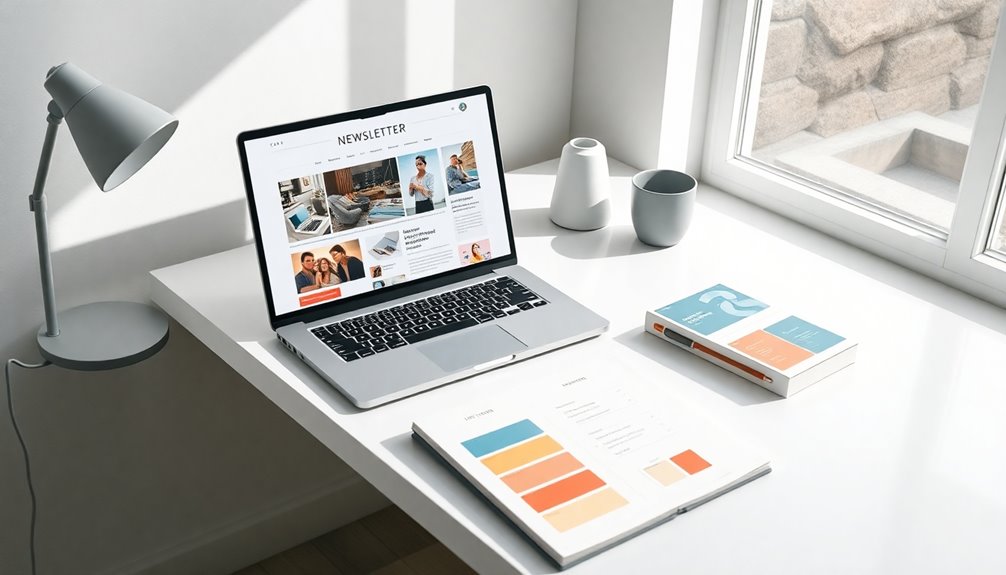
To create an engaging minimalist newsletter, you can seamlessly incorporate high-quality visuals and compelling calls-to-action (CTAs) that resonate with your audience.
Here's how to effectively integrate these elements:
- Use high-quality visuals that align with your content and brand identity, boosting engagement and increasing click rates.
- Design clear calls to action that stand out through contrasting colors, guiding readers toward desired actions without overwhelming them.
- Maintain a balance between text and images to enhance readability; an ideal text-to-image ratio keeps your newsletter inviting.
Remember to test your newsletter by experimenting with different types of CTAs, such as buttons versus text links, to find what drives the most engagement.
Testing Your Design Across Devices

Testing your newsletter design across devices is essential for guaranteeing your audience has a consistent and engaging experience.
Testing your newsletter design across various devices ensures a seamless and captivating experience for your audience.
You should check how your newsletter looks on multiple devices, including smartphones, tablets, and desktops, to maintain formatting and readability.
Verify how it renders in different email clients like Gmail, Outlook, and Apple Mail to identify any compatibility issues.
Utilize tools such as Litmus or Email on Acid to preview your design across various platforms and screen sizes before sending.
Additionally, verify all images load properly and that alt-text is visible for accessibility.
Finally, confirm that links, especially calls-to-action, work correctly on all devices to enhance user engagement and drive desired actions.
Gathering Feedback for Continuous Improvement

Gathering feedback from your subscribers not only helps you understand what content resonates but also fosters a sense of community around your newsletter.
Here are three effective ways to encourage engagement and gather valuable feedback:
- Surveys and Polls: Incorporate short surveys or polls within your newsletter to streamline the feedback process. This makes it easy for subscribers to share their thoughts on your content and design.
- Analyze Metrics: Monitor open rates and click-through rates to gauge which sections are most appealing. This indirect feedback can guide your content decisions.
- Responsive Changes: Implement changes based on the feedback you receive. Demonstrating responsiveness shows your commitment to improvement, potentially increasing loyalty and retention among your audience.
Planning Content for Future Newsletters
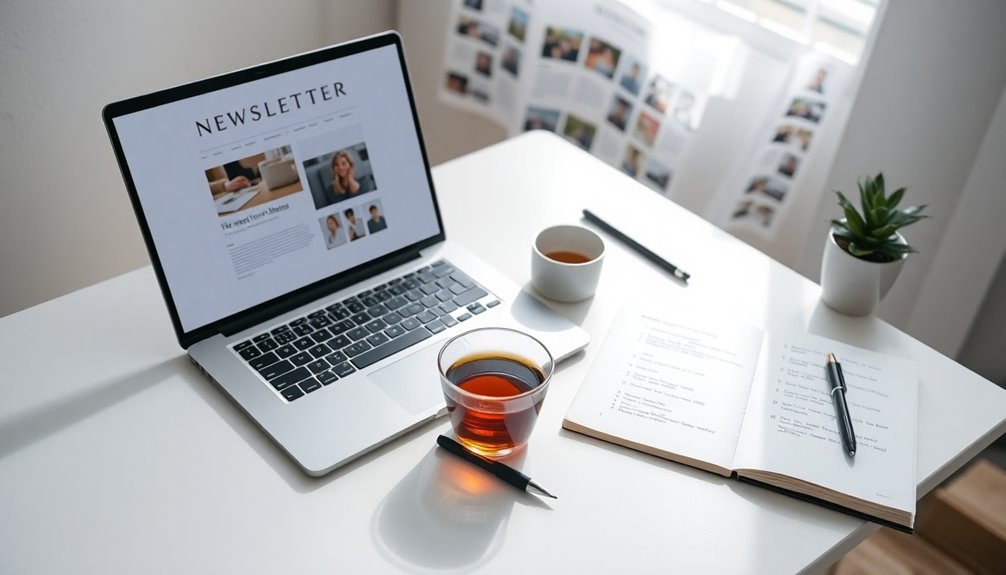
As you plan content for future newsletters, it's essential to keep your audience's interests at the forefront.
Start by collecting and organizing relevant links and resources that align with your newsletter's theme. Identify key topics that resonate with different audience segments using feedback and engagement metrics, ensuring you deliver great content.
Establish a content calendar to schedule your email newsletters, allowing for timely communication. Consider mixing content types, such as articles, tools, and tips, to enhance the reading experience and keep subscribers engaged.
Regularly review and adjust your strategy based on preferences and engagement rates, ensuring your newsletters remain relevant and appealing to your audience.
This proactive approach will lead to consistent growth and connection with your readers.
Tools and Resources for Efficient Design

Creating a visually appealing newsletter doesn't have to be complicated. With the right tools and resources, you can enhance your design process and boost visual engagement.
Here are three essential tools you should consider:
- Canva & Placeit: These platforms offer customizable templates that allow for quick and efficient design tailored to your minimalist approach.
- Adobe Express: Perfect for beginners, it provides user-friendly features for creating stunning newsletters without needing extensive design experience.
- Unsplash: Source high-quality images from here to maintain a professional appearance in your content creation.
Additionally, use color contrast detectors to guarantee text visibility and accessibility. This ensures your newsletter reaches a broader audience while adhering to minimalist design principles.
Frequently Asked Questions
How to Create a Newsletter Step by Step?
To create a newsletter step by step, start by defining your goals.
Decide what actions you want subscribers to take and structure your content around these objectives.
Choose a minimalist template that highlights readability, with bold headlines and clear calls-to-action.
Outline your key takeaways, ensuring each section is concise.
Finally, test your newsletter on various devices to confirm compatibility and readability before you hit send.
What Are the 3 Pillars That Go Into Designing a Great Newsletter?
When you think about designing a great newsletter, coincidence plays its part in three essential pillars: clarity, engagement, and consistency.
You'll find that clarity helps your readers quickly grasp the message.
For engagement, storytelling and visuals create connections that resonate.
Finally, consistency in design elements builds trust and brand recognition.
How Do You Make a Good Newsletter Design?
To create a good newsletter design, start with a clear goal and structure your content around actionable calls-to-action.
Use a minimalist approach with clean layouts, keeping the width within 600 pixels.
Place essential information in the top 300 pixels for immediate visibility.
Incorporate bold headlines and concise paragraphs for better readability, and test your design across devices to guarantee compatibility.
Finally, gather feedback to refine your strategy and enhance engagement.
Can Canva Design Newsletters?
Absolutely, Canva can design newsletters!
Think of it as your digital canvas, where creativity flows effortlessly. With its user-friendly interface and customizable templates, you can craft newsletters that reflect your unique brand.
You'll find a treasure trove of design elements like images and icons, enhancing your minimalist aesthetic.
Plus, you can collaborate with your team in real time, ensuring everyone's ideas come together beautifully.
Export your masterpiece easily, ready for distribution!
Conclusion
By embracing a minimalist approach, you're setting the stage for impactful newsletters that speak directly to your audience. Remember, less is often more—when you strip away the clutter, your core message shines like a beacon. Keep refining your design based on feedback, and don't shy away from experimenting with new layouts and content. With the right tools and a clear vision, you'll create newsletters that not only engage but also resonate deeply with your readers.


